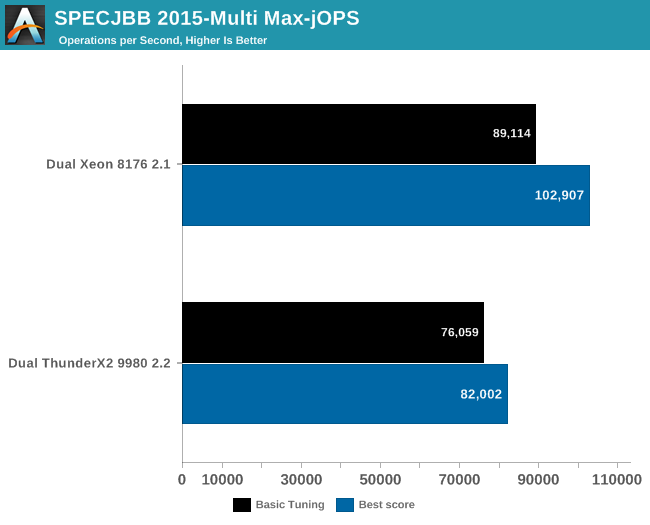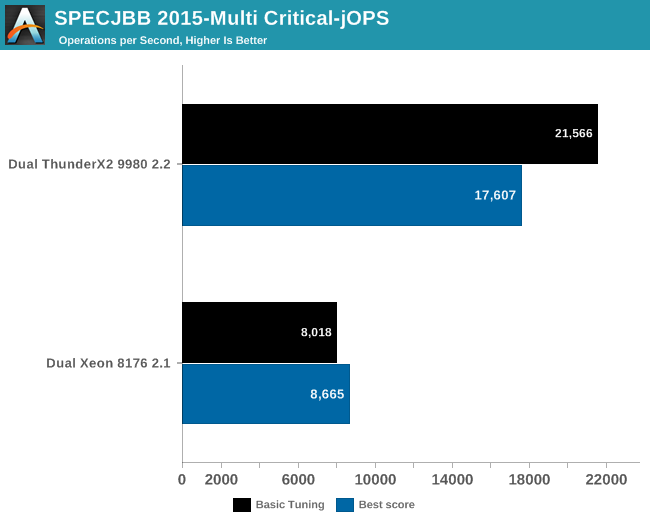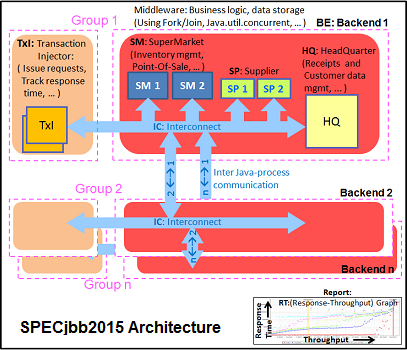Assessing Cavium's ThunderX2: The Arm Server Dream Realized At Last
by Johan De Gelas on May 23, 2018 9:00 AM EST- Posted in
- CPUs
- Arm
- Enterprise
- SoCs
- Enterprise CPUs
- ARMv8
- Cavium
- ThunderX
- ThunderX2
Java Performance
The SPECjbb 2015 benchmark has "a usage model based on a world-wide supermarket company with an IT infrastructure that handles a mix of point-of-sale requests, online purchases, and data-mining operations." It uses the latest Java 7 features and makes use of XML, compressed communication, and messaging with security.
Note that we upgraded from SPECjbb version 1.0 to 1.01.
We tested SPECjbb with four groups of transaction injectors and backends. The reason why we use the "Multi JVM" test is that it is more realistic: multiple VMs on a server is a very common practice, especially on these 100+ threads servers. The Java version was OpenJDK 1.8.0_161.
Each time we publish SPECjbb numbers, several people tell us that our numbers are too low. So we decided to spend a bit more time and attention on the various settings.
However, it is important to understand that the SPECJbb numbers published by the hardware vendors are achieved with the following settings, which are hardly suitable for a production environment:
- Fiddling around with kernel settings like the timings of the task scheduler, page cache flushing
- Disabling energy saving features, manually setting c-state behavior
- Setting the fans at maximum speed, thus wasting a lot of energy for a few extra performance points
- Disabling RAS features (like memory scrub)
- Using a massive amount of Java tuning parameters. That is unrealistic because it means that every time an application is run on a different machine (which happens quite a bit in a cloud environment) expensive professionals have to revise these settings, which may potentially cause the application to halt on a different machine.
- Setting very SKU-specific NUMA settings and CPU bindings. Migrating between 2 different SKUs in the same cluster may cause serious performance problems.
We welcome constructive feedback, but in most production environments tuning should be simple and preferably not too machine-specific. To that end we applied two kinds of tuning. The first one is very basic tuning to measure "out of the box" performance, while aiming to fit everything inside a server with 128 GB of RAM:
For the second tuning, we went searching for the best throughput score, playing around with "-XX:+AlwaysPreTouch", "-XX:-UseBiasedLocking", and "specjbb.forkjoin.workers". "+AlwaysPretouch" zeroes out all of the memory pages before starting up, lowering the performance impact of touching new pages. "-UseBiasedLockin" disables biased locking, which is otherwise enabled by default. Biased locking gives the thread that already has loaded the contended data in the cache priority. The trade-off for using biased locking is some additional bookkeeping within the system, which in turn incurs a small performance hit overall if that strategy was not the right one.
The graph below shows the maximum throughput numbers for our MultiJVM SPECJbb test.

The ThunderX2 achieves 80& to 85% of the performance of the Xeon 8176. That should be high enough to beat the Xeon 6148. Interestingly, the top scores are achieved in different ways between the Intel and Cavium systems. In case of the Dual ThunderX2, we used:
Whereas the Intel system achieved best performance by leaving biased locking on (the default). We noticed that the Intel system – probably due to the relatively "odd" thread count – has a slightly lower average CPU load (a few percent) and a larger L3-cache, making biased locking a good strategy for the that architecture.
Finally, we have Critical-jOPS, which measures throughput under response time constraints.

With this many threads active, you can get much higher Critical-jOPS by significantly increasing the RAM allocation per JVM. However, it really surprising to see that the Dual ThunderX2 system – with its higher thread count and lower clockspeed – has a much easier time delivering high throughputs while still keeping the 99th percentile response time under a certain limit.
Increasing the heap size helps Intel to close the gap somewhat (up to x2), but at the expense of the throughput numbers (-20% to -25%). So it seems that the Intel chip needs more tuning than the ARM one. To investigate this further, we turned to "Transparant Huge Pages" (THP).











97 Comments
View All Comments
DrizztVD - Wednesday, May 23, 2018 - link
It amazes me how the one big advantage ARM could have is the power efficiency, yet no power efficiency numbers in this review? It's like someone just isn't thinking about what can best showcase the ARM advantage and testing it.boeush - Thursday, May 24, 2018 - link
You must have missed this bit:"So as is typically the case for early test systems, we are not able to do any accurate power comparisons.
In fact, Cavium claims that the actual systems from HP, Gigabyte and others will be far more power efficient."
This was an early (and apparently quite buggy, especially from the power management standpoint) test system. It's not representative of final production systems in these respects, so doing what you request on it would only put a very crude lower bound on efficiency, at best.
That's why the final section of the write-up has a title ending in ": so far"... (obviously, there will be more to come if/when real production-quality systems are available for benchmarking/analysis.)
ZolaIII - Thursday, May 24, 2018 - link
It's broken currently on the MB. If you want to see real power/performance metrics for a SoC made on comparable lithography to the lintels 14 nm (aka TSMC 10nm) & with optimised software read this:https://blog.cloudflare.com/neon-is-the-new-black/
drwho9437 - Wednesday, May 23, 2018 - link
Thanks Johan, I've been reading since Ace's. I can't believe it has been more almost 20 years. Even though I don't work in this market I still read everything you write.JohanAnandtech - Friday, May 25, 2018 - link
It was indeed almost 20 years ago that I published my first article about the K6-2 vs Pentium MMX. And Anand's star was about to rise with the launch of the K6-3 :-).Spatz - Wednesday, May 30, 2018 - link
Wow. Aces hardware... that used to be my go to for hardware reviews back in the day. I can’t believe your still at it! This article was great. Keep up the good work.beginner99 - Thursday, May 24, 2018 - link
So it for sure is an option. however I d not get the focus on price. The CPU cost is a small fraction of the total server cost and a tiny if infrastructure cost (network, HVAC,...) is included. Add to that the software and data running on that server and if your CPU is 5% faster at same power it costing $5000 more might be totally worth it.Apple Worshipper - Thursday, May 24, 2018 - link
Errmm... does ARM feature SMT now?Ryan Smith - Thursday, May 24, 2018 - link
Not in Arm's own cores. But in Cavium's ThunderX2, yes.sgeocla - Thursday, May 24, 2018 - link
What's up with EPYC comparison missing in almost all benchmarks?EPYC has been out for a while and the only benchmarks are from almost a year ago?